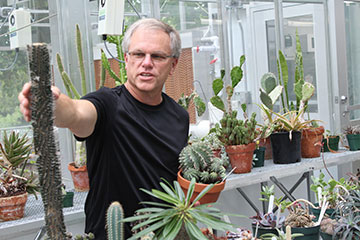
08/24/2017
“Going green” takes on new meaning at SUNY Cortland.
That’s because the brand-new replacement greenhouse constructed during the spring and summer beside Bowers Hall has suddenly acquired about 100 rare and unusual plants for current and future biological sciences majors to study.
The College has made a new home for a large Calatropsis procera, which is a northern African species in the milkweed family. Also, a modest-looking Ceratonia siliqua, otherwise known as a carob plant, sits ready to produce that flavor used as a chocolate or coffee substitute. Another specimen, a Pilocarpus jaborandi, contains the alkaloid that was the first treatment for glaucoma, an eye disorder.
Now there’s a smaller-growing but still sizeable specimen of the Amorphophallus or “Corpse Flower,” the famous giant plant that makes national news at Cornell University when its rare and stinky six-foot tall single flower spike blooms for only a couple days at very infrequent intervals of up to seven years.
The new collection of specimens — acquired for their beauty, whimsy, educational or useful purpose — represent a generous gift to the College from the United States Botanic Garden (U.S.B.G.), said Steven Broyles, professor and chair of the Biological Sciences Department.
Steeped in history, rich with tradition, the living plant museum established in 1820 by the U.S. Congress informs visitors about the importance, and often irreplaceable value, of plants to the well-being of humans and to earth's fragile ecosystems. One of the oldest botanic gardens in North America, the U.S.B.G. has been administered through the Architect of the Capitol since 1934.
There can be no price set on the U.S.B.G.’s collection of assorted botanic genera from around the world, Broyles noted.
“Some of these are plants that you can’t even find on the Internet,” Broyles said of the new collection. “I was actually asking them about the dollar value to their collection and they don’t know it.”
 |
|
| These fascinating South African succulents - with fleshy, water-saving stems - have evolved to grow between crevices. |
Broyles’ grown sons, Chris and Cortland, work in Washington, D.C., and the official Botanic Garden is located adjacent to the U.S. Capitol grounds.
“I had visited the United States Botanic Garden many times over the years,” Broyles said. In December he was inspired to ask to ask the director to give the College some plants.
“It was a shot in the dark,” he said. “I sent the director a very nice letter and an email. Within about an hour, I had a response.”
He was invited to visit the botanic garden’s production facility about six miles outside of Washington, D.C., and discuss a plant gift.
In February, Broyles and his wife, Susan Sherman-Broyles, spent two hours wandering among the cactii and bromeliads with the director, Ari Novy, and the collections curator, William McLaughlin. It was a botanist’s dream. Broyles noted that at the botanic garden, much of the facilities, including a succulent (cactus) greenhouse the size of the Sperry Center footprint and an orchid-only growing area triple the size of SUNY Cortland’s greenhouse — are devoted to reproducing what the living museum already has.
“They showed us everything and told us to develop a list,” Broyles said. “They would see what they could do. It was wonderful.”
Botanic garden staff recently separated and potted the chosen specimens and, on Aug. 17, Broyles made the approximately 14-hour, 300-mile roundtrip to Alexandria, Va., to pick up the bounty.
He spent six additional hours with the curator on the 17th, gathering last-minute flora.
“There’s several things in here that they just said, ‘Here, you’ll like it, just take it,’” Broyles said. “And there are some things I just walked by and asked, ‘Can I have that?’”
The botanic garden staff were very sympathetic to the College’s need.
“In my letter and email, I described our campus and our collection and what had happened to it,” Broyles said.
The College’s former plant collection had largely burned or froze to death inside the inhospitable glass walls of the former pair of very old greenhouses, one attached to and a second located nearby Bowers Hall. Only a few dozen plants remain from the old greenhouse.
“When I came here in 1992, I had the University of Georgia ship about 100 plants in big boxes,” said Broyles, a botanist who has specialized in varieties of what are commonly called milkweed plants. “And not a single plant survived the first winter. Our greenhouse would get to about 120 degrees in the winter because the power plant steam lines ran under them.
“It set back my research right away. Because I knew we couldn’t grow anything in our greenhouse,” Broyles said.
The College discontinued using a main steam line to heat the campus about five years ago, ending that dilemma but afterward, the aging, former glass structure failed to keep out the cold. Two entire collections were lost in one single winter.
The sparkling, new greenhouse — with three separate growing areas for tropical, desert and research flora — promises a fresh start. One bay reserved for research has a hearty collection of five milkweed species and a few dangling chrysalises cases of the Monarch butterfly larvae. Milkweed is their only food.
A ribbon cutting ceremony to celebrate both the greenhouse and a new science museum inside the renovated Bowers Hall will take place on Thursday, Sept. 28.
“I will send a letter to my Congresswoman (Claudia Tenney, R-New Hartford) telling her about my marvelous experience at the United States Botanic Garden,” Broyles said.